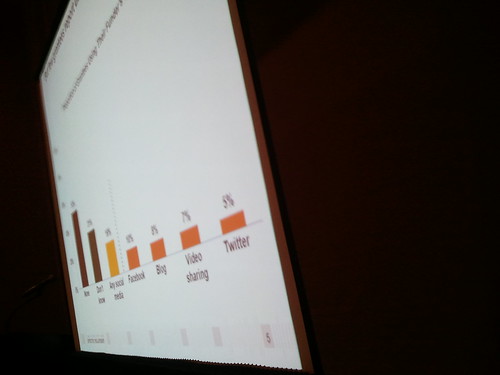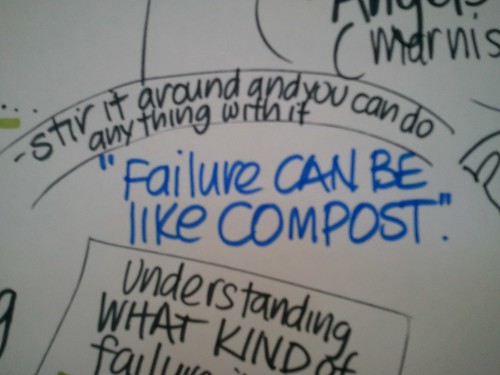
This week I attended Center for Effective Philanthropy’s conference “Better Philanthropy: From Data to Impact” where I participated on a panel about social media, foundations, and grantees. Vincent Stehle moderated and other panelists included Paula Goldman, Omidyar Network, Jacob Harold, Program Officer, The William and Flora Hewlett Foundation, and Travis Manzione, Director of Assessment Tools for CEP.

Travis Manzione shared some preliminary data from a survey of over 2,000 grantees from 9 foundations about their social media usage. For the most part, foundations are using social media as a one-way communications tool about their programs, not for interaction with grantees. Grantees are reading about foundation’s programs through social media channels, but not engaging with funders. A skeptic’s view might be: why waste time? Another lens, ask why?
I shared a few points about nonprofits use of social media, including a maturity of practice model called “Crawl, Walk, Run, Fly.” This prompted discussion about the similarities and differences in practice between nonprofits and foundations and how to move to the next level. There were questions about social media policies as well as content and engagement strategies and handling mistakes. It all comes down to intention, capacity, and audience as Jacob Harold observed.
Paula Goldman shared some thoughts about foundation intent in using social media, particularly amplifying grantees work and thought leadership. In addition, Kathy Reich, mentioned the potential of using social media to help inform and improve grant-making strategy and broader field impact.
Jacob Harold discussed how social media can be of value to a program officer: it is an easy way to stay informed about grantees activities with anecdotal information. It can also facilitate informal communications with other people in the grantee organization. He also added that it is important to have structured information.

Transparency was a theme that came up throughout the conference. In our session, Vincent Stehle provoked with this: “We want to be transparent except when it matters.” Transparency isn’t a black and white definition- share everything or share nothing. Transparency isn’t a means to end, but is part of a ladder or scaffolding, particularly if used to spark public learning about how to make grantmaking strategies more impactful.

The theme of learning from grants that were not that successful also surfaced as it did during the Networked Funders convening last month where a new phrase as coined: “Compost Grantmaking. This refers to grants for projects that were ahead of their time or more experimental. Projects that didn’t quite work out perfectly. Later, they turn out to be a rich source of learning to avoid replicating mistakes.
I attended a round table discussion with Kathy Reich and Paul Connolly about some of the very preliminary findings from the Packard Foundation’s “Goldmine” evaluation that analyzes 1300 capacity building grants to find out what works and how to improve impact.
Kathy Reich offered some context. The Packard Foundation Organizational Effectiveness program came out of David Packard’s belief that nonprofits needed to invest in themselves – coaching, leadership, strategic planning – as the for-profit world does. The foundation’s grant making and thought leadership spurred the development of the nonprofit organizational effectiveness movement.
The last evaluation of this work was a decade ago. Thus, a retrospective evaluation of capacity building grants would not doubt produce a “goldmine” of insights for in the field. The Packard OE program is working with the TCC Group to analyze this rich data set to answer these questions:
- What is the sustained impact of the grants we make?
- How and to what extent can we quantify impact, its staff, and their outcomes
- What contributes to the consultant relationship success?
- What are the factors that contribute to a successful OE project?
While the ultimate goal is to improve the grantmaking strategy and impact , they are also experimenting with sharing the evaluation process and preliminary findings on the wiki as part of a “public learning” process. It is just getting underway both online and offline.
A couple of nuggets that Paul Connolly shared about the design of capacity grants based on his deep expertise in this area. He talked about “transformative” versus “transactional” capacity building approaches. The former being a strategic planning process that changes the way the organization works. Transactional capacity building are projects like building a web site or accounting system.
Paul also mentioned the “ready, set, go” framework. Many consultant engagements focus on the “ready, set” part – expert consulting that helps grantees prepare to implement – an assessment, research, or a strategy. He suggested that the “go” is very important and approaches such as peer exchanges or coaching as the organization implements are highly effective in getting to transformative results.
As a nonprofit consultant that works on capacity building projects, I’m always looking to improve my practice. You can get feedback from clients and keep up on a never ending stream of topic or subject-matter information. But data about how to design capacity building, the trade craft of practice, and what nonprofits are looking for in a consultant and consulting relationship are not quite as plentiful and can be pure gold!
